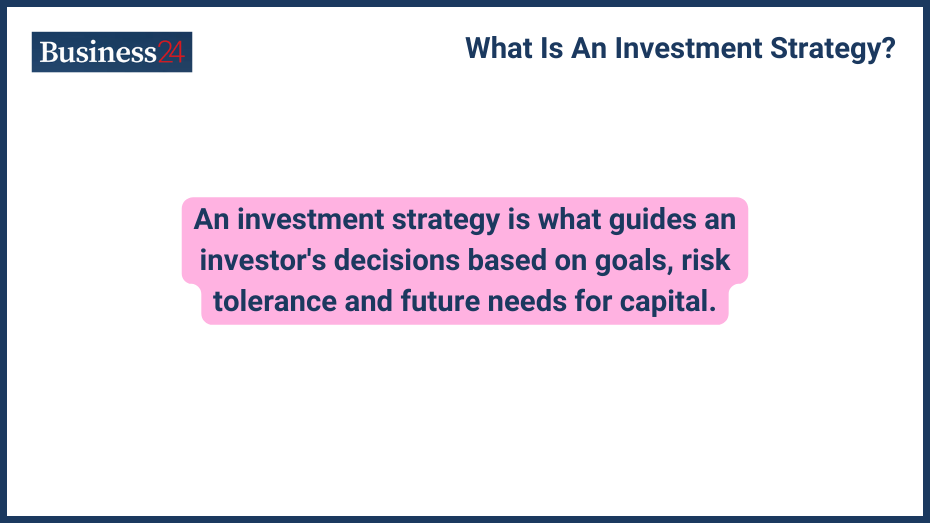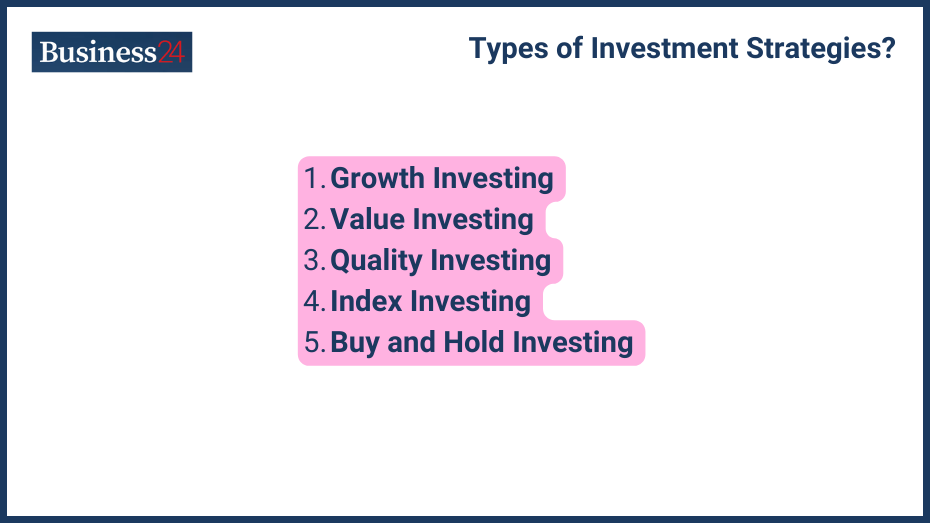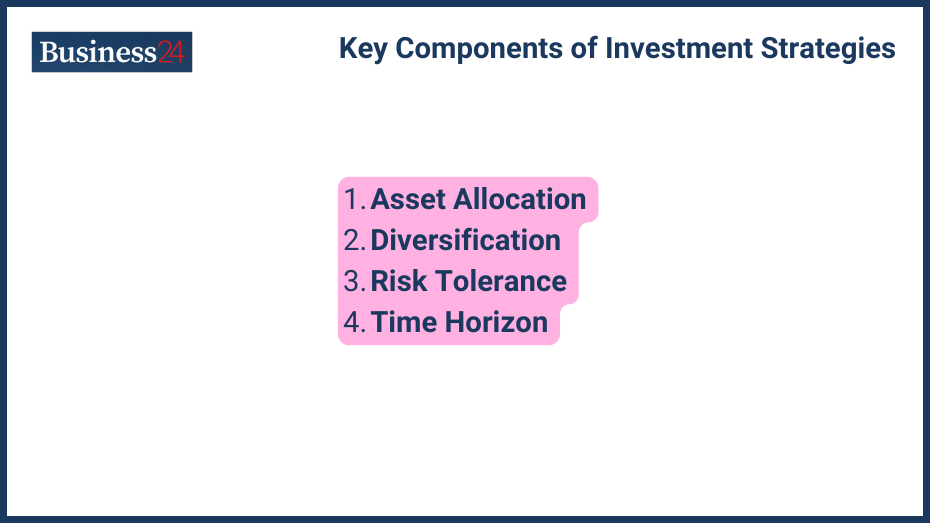
An investment strategy is what guides an investor’s decisions based on goals, risk tolerance and future needs for capital.
Everyone has a different investment goal with varying risk appetites and time durations for the investment. There are other investment strategies for the people’s various investment needs. As an investor, you need to know the methods available to choose from according to different situations.
An investment strategy is a well-defined method and the principles an investor uses to build his portfolio. It’s a framework built by considering your risk tolerance, investment goals, and holding duration to create a personalized approach to investing.
This guide will discuss investment strategies in detail so you can make your investment plans wisely.
What is an example of a strategic investment?
Let’s talk about Tina, a young professional who is saving for retirement in 20 years and wants to start investing early. For this age, assuming she will work for at least 10-15 years, she has a high-risk tolerance and wants to focus on long-term growth.
Her investment strategy may involve allocating a large portion of her portfolio to growth stocks in sectors like technology or healthcare, which in the future have the potential to become a multi-bagger. She wouldn’t want to buy funds that give 10-15% annually; she has a lot of time for her investment, and purchasing growth stock from a large part of her portfolio will be best for her.
What Are the Types of Investment Strategies?

Growth Investing
A growth investing strategy aims to grow the capital more than the industry average returns. Growth investment strategies are used in good fundamental companies with sectoral tailwinds. In growth investing, intensive research is required to find such investment opportunities, but with hard work, returns are also huge. Growth investors are drawn to companies reinvesting profits in research and development, aiming for significant future expansion. For ex. Tesla, Amazon, etc.
Value Investing
Value investors seek diamonds in the rough. They focus on undervalued stocks, where the current market price is believed to be significantly lower than the company’s intrinsic value. When you are able to buy such stocks below its valuation and when they cross the valuation, you can book some handsome profits.
Being a value investor is hard; you must be experienced and research various scripts like growth investors.
Quality Investing
In quality investing, you have to look for companies that have already proved themselves. You have to look for companies with exceptional characteristics, such as strong and experienced management teams, consistent profitability, and a solid track record.
These qualities position companies for sustainable growth and outperformance over the long term.
Index Investing
When you don’t want to go for single stock or bond-specific investment strategies and want to choose a broader market for investment, you can invest in an index. Index funds mirror the performance of a market index, such as the S&P 500. This strategy offers broad diversification and requires minimal management compared to actively selecting individual stocks.
Buy and Hold Investing
Warren Buffet, one of the greatest investors of all time, is a buy-and-hold investor. In a Buy-and-hold investment strategy, you focus on buying quality investments and holding them for extended periods, regardless of short-term market fluctuations. You have to be confident in your investment because you will see many short-term fluctuations in the market.
What Are the Key Components of Investment Strategies?

A sound investment strategy rests on four key components:
- Asset Allocation: No one has an unlimited amount of capital, it is important for an investor to allocate the right amount to any strategy. This is the art of dividing your investment portfolio among various asset classes, such as stocks, bonds, real estate, and cash equivalents. Asset allocation is crucial for managing risk, as different asset classes have varying risk-return profiles.
- Diversification: You would have heard of the quote, “ Don’t put all your eggs in one basket!” Diversification is very important for risk management. You must spread your investments across various asset classes, industries, and companies. This way, a downturn in one area is potentially offset by gains in another.
- Risk Tolerance: As an investor, your first duty is to save and manage your capital. So before choosing an investment strategy thoroughly examine the risk associated. Investors with a high-risk tolerance can withstand greater fluctuations in exchange for the possibility of higher returns. Conversely, risk-averse investors might prioritize capital preservation and focus on more conservative investments.
- Time Horizon: You could have some fixed goal for your investment like I want to hold it for 5 or 10 years. Long-term investors are buy-and-hold investors, and they aim for growth and compounding each year. At the same time, short-term investors look for churn and grow their capital by buying and selling freely.
What Are the Benefits of Having an Investment Strategy?
Having a well-defined investment strategy offers several advantages:
- Clear Direction: You will make an investment strategy considering your investment goals, period of holding, and risk appetite. In calculating all these things, an investment strategy will give you a clear direction toward your investment goals.
- Risk Management: By understanding your risk tolerance and allocating assets accordingly, you can create a portfolio positioned to weather market volatility.
- Consistency: Being disciplined and not acting on impulsive decisions will help you as an investor. You’ll be more likely to stick to your plan and avoid selling at a loss due to panic.
What Are the Risks Associated with Investment Strategies?
Even the most strategic plans can encounter challenges, so there will be risks associated, and you should know how to face them:
- Market Risk: No one knows what is going to happen next, and the same works for the market, too. There is always an inherent risk that the market can decline in value and cause your investment’s value to decline.
- Inflation Risk: Inflation decreases purchasing power over time, and if your investment can’t beat inflation, you will lose purchasing power in the future.
- Interest Rate Risk: Changes in interest rates can affect the value of certain investments, such as bonds. Rising interest rates can lead to a decrease in bond prices and also affect the stock market.
What Are Some Common Investment Styles?
Active Investing
Active investors take a more hands-on approach. They continuously research and analyze the market, aiming to identify undervalued stocks or investment opportunities with high growth potential.
They actively buy and sell securities within their portfolio to make a profit on market movements and potentially outperform the market. Active investing requires significant time, research, and expertise; you must treat it as a full-time business.
Passive Investing
Benjamin Graham and Warren Buffett are passive inventors. Passive inventors do not frequently buy and sell; they believe more in buy-and-hold investing strategies.
Passive investing requires less ongoing management and research compared to active investing. However, it also means accepting the market’s average return, forgoing the possibility of exceeding it through active selection.
How to Choose the Right Investment Strategy?
Ask these questions to yourself: What do you hope to achieve with your investments? Are you saving for retirement, a down payment on a house, or a child’s education? Understanding your goals will guide your risk tolerance and investment choices. Knowing things like how much you are comfortable to lose gives you confidence in your investment strategy.
When selecting an investment option, it is important to ask yourself, How long do you plan to invest before needing the money? You have to assess your financial needs and goals in mind to choose the right investment strategy.
What is a business’s investment strategy?
A company’s investment strategy is connected with its operations and how it allocates capital to various assets, such as new equipment, research and development, or acquisitions. A business aims to maximize operation capacity and efficiency by strategically investing in growth and profitability opportunities.
What investment strategy is the best?
No one can answer this question for you, neither me nor the best investor in the world. Because I don’t know what your capital, risk tolerance, and investment goals are. To choose the best investment strategies, write down your needs and compare all the investment strategies; the one that fits all your needs and goals could be the investment strategy for you.
Practical Applications and Case Studies
You can learn from the different approaches and investors who have made big returns from the investments. One of the best investors of the century, Investing legend Warren Buffett is renowned for generating oversized returns. From 1965 to 2023, his company, Berkshire Hathaway, delivered compounded annual gains of 19.8%, substantially outperforming the S&P 500’s 10.2% annual return during the same period.
Educational Resources and Tools
Various books and research papers are available on investment topics. Just search for investment on Google, and you will find so much material that you will not be able to finish it in your lifetime.
Some of the famous books are The Intelligent Investor, One Up on Wall Street, The Warren Buffett Way, etc. There are plenty of online courses and videos from where you can learn the basics of investments. However, real market experience is the best way to learn.
Online calculators and planning tools can be immensely helpful. They can assist you in determining your risk tolerance, asset allocation, and potential returns based on different investment strategies. Utilize these tools to model various scenarios and make informed investment decisions.
Disclaimer
eToro is a multi-asset platform which offers both investing in stocks and cryptoassets, as well as trading CFDs.
Please note that CFDs are complex instruments and come with a high risk of losing money rapidly due to leverage. 51% of retail investor accounts lose money when trading CFDs with this provider. You should consider whether you understand how CFDs work, and whether you can afford to take the high risk of losing your money
This communication is intended for information and educational purposes only and should not be considered investment advice or investment recommendation. Past performance is not an indication of future results.
Copy Trading does not amount to investment advice. The value of your investments may go up or down. Your capital is at risk.
Don’t invest unless you’re prepared to lose all the money you invest. This is a high-risk investment and you should not expect to be protected if something goes wrong. Take 2 mins to learn more
eToro USA LLC does not offer CFDs and makes no representation and assumes no liability as to the accuracy or completeness of the content of this publication, which has been prepared by our partner utilizing publicly available non-entity specific information about eToro.
